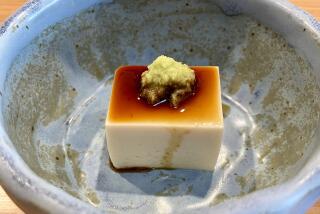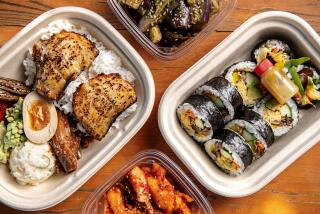Steep It, Froth It or Make It Into Soup
- Share via
There are several varieties of Japanese green tea available in America.
* Matcha is a bright jade-green tea that is served mostly at formal tea ceremonies. It is made from the budding leaves of the tea plant, dried and crushed to a fine powder in a stone mill. Matcha is not steeped in hot water but simply added and whipped to a froth. The taste is slightly bitter, but it is mellow on the tongue.
To make one serving of matcha, add half a cup of boiling water to a tea bowl. With a whisk, whip two teaspoons of tea powder into the hot water until it becomes frothy. Serve immediately.
* Sencha is tea of the highest quality made from the first harvest in May. Freshly picked leaves are steamed, quickly cooled and rolled by hand or machine. It is appreciated not so much as a thirst quencher as for its fragrance. It has a pleasant bitter flavor and lovely light green color.
To make four servings of sencha, bring one cup of water to a boil, let it stand for two minutes, then pour into a pot with two teaspoons of tea leaves. Let it stand for one minute and then pour the tea bit by bit from one cup to another, so everyone gets an equal amount of tea of equal strength. Sencha that contains popped rice is called genmai-cha. It has a robust flavor.
* Bancha is made from mature tough tea leaves and twigs. It is often roasted, which gives the leaves a brown color. Bancha is a good basic tea with a toasty, non-bitter taste that suits all occasions. A few twigs and stems at the bottom of your cup are considered attractive and interesting. If a twig or stem is seen afloat in the teacup in a vertical position, which is rare, it is regarded as a sign that good luck is coming your way.
To make four servings of bancha, put two to three tablespoons of tea leaves into a pot. Add two cups boiling water and let the tea steep for one minute.
* One of the popular informal ways to drink green tea is as a soup called ochazuke. It is made by pouring hot green tea over steamed rice--usually the last few bites of rice left over in the rice bowl. Ochazuke serves two purposes: to help digestion and rinse the sticky rice bowl at the end of a meal. My grandmother often puts in an umeboshi (pickled plum) to add flavor.
To make ochazuke, make sencha, genmai-cha or bancha and pour the hot tea into a bowl of rice. Bring the bowl to your lips, sip the tea soup and guide the rice to your mouth with chopsticks. Japanese pickles such as umeboshi complement the flavor of tea.
Sonoko Sakai


